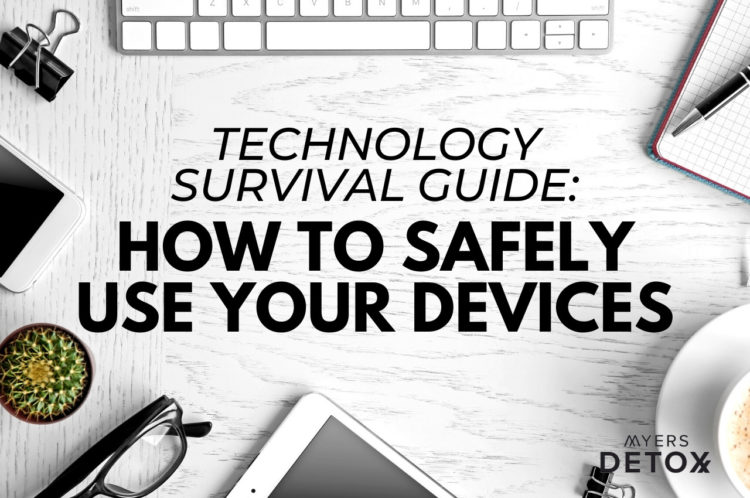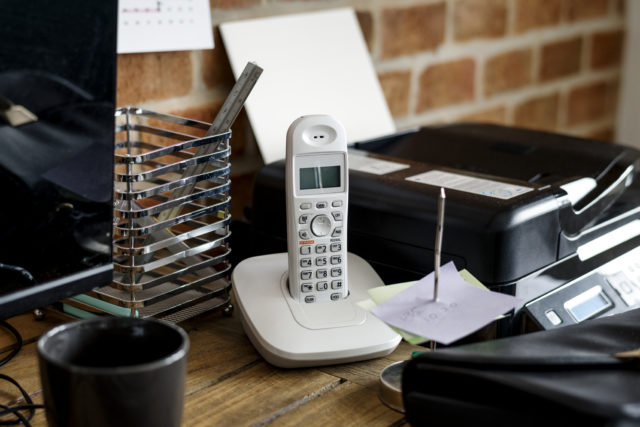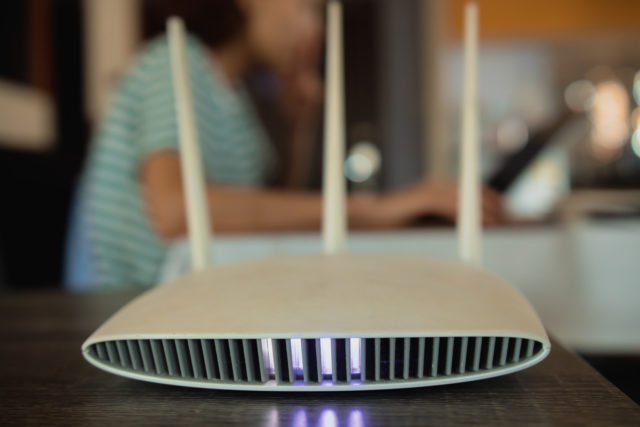Technology Survival Guide: How to Safely Use Your Devices

Technology isn’t going anywhere, but you have options when it comes to how you use tech. Learn how to safely use your devices in this technology survival guide!
There’s a lot to be said about the advances in technology we’ve seen over the last 20, 30, even 40 years. While, on the one hand, technology has brought us closer on a global scale, allowed for advances in medicine, and assisted in moving us towards more environmentally-friendly options like electric vehicles, there are some serious downsides that have come along with these developments.
Most notably, the amount of electromagnetic frequencies (EMFs) polluting our airways is larger today than we could have even imagined 100 years ago.
In this article, we’ll discuss:
- Why you should never place your “laptop” on your lap
- Where the largest sources of hidden EMF are lurking in your own home
- Why your fitness device may be ruining your health
- How to set up your sleeping environment to be more tech-safe
- Why we have more EMF radiating in our homes today more than ever
- And more
How To Safely Use Technology: Do’s and Don’ts
#1 Cell Phones

Cell phones have become our everyday companions. If you’re like most people, you don’t leave home without your phone either in your pocket or tucked away in your purse. Although your phone may keep you connected with the outside world, it is a constant source of EMFs.
Research shows that EMFs from cell phones may alter brain physiology and the functioning of your stem cells through its impact on the human biofield[1]. To mitigate some of the potential harm that cell phones can have on your physiology, follow these suggestions:
Do:
- Use a speakerphone or airtube headset when talking on the phone or listening to music or podcasts.
- Turn the power off if you need to put a phone in your pocket.
- Choose a wired phone when you can, especially for longer calls. If you don’t have a wired phone at home or in the office, consider getting one installed.
- Set Airplane mode ON with WiFi OFF more often.
- Power off Cell Phones in a car, a bus, train, airplane, elevator.
Don’t:
- When using the phone, never touch your head or body with the phone, keep it at a distance as much as possible.
- Don’t use a cell phone when the network signal is weak, because then the radiation from the phone is higher.
- Don’t carry a cell phone in your bra.
- Don’t carry a cell phone in any clothing pocket.
- Don’t sleep with a cell phone or tablet or any wireless electronics near your head.
#2 Home Phones

While home phones are a much better option than cell phones, it is crucial that they be wired, not wireless. Research into the impact of mobile, cordless, and wired phones shows that both mobile and cordless phones emit EMF radiation in a range that makes them possible human carcinogens[2].
DECT (Digital Enhanced Cordless Technology) phones constantly emit microwave radiation. That means that the base for your cordless phone is like a little microwave that you have plugged in throughout your home.
To avoid the dangers of cordless home phones, follow these guidelines:
Do:
- Get a Corded Phone for your home.
- Keep your landline.
- Run lines into all the rooms where you need a phone.
- Use a wired VOIP (Voice over Internet Protocol) system.
Don’t:
- Use wireless phones in your home
- If you do have one, unplug it from its base or keep it out of your bedroom at night.
#3 Printers

In the past, it would be rare to have a printer in your home unless you had a home office. Today, however, the home office is the new norm, and with it comes a whole host of technological gadgets. Since most of the printers on the market today use WiFi, you can be sure that they’re emitting a steady stream of EMF into your environment.
Luckily, you have options when it comes to at-home printers. When possible, follow the below guidelines:
Do:
- If you have the option, use cords to connect your printer.
- Purchase a non-WiFi printer.
- If you must use a WiFi printer: set the WiFi function to its lowest setting.
- Unplug the printer when it’s not in use.
Don’t:
- Don’t place a wireless printer in your office near your workspace. Wireless printers constantly emit microwave radiation and should not be located near our bodies per the manufacturer’s instructions.
#4 Tablets and Laptops

Many people are moving from large desktop computers to smaller, more portable tablets and laptops these days. This can make work-on-the-go much easier and give you more flexibility as to where you set up shop.
Unfortunately, this also means that these smaller devices are held closer to your body than a large desktop.
Research shows that the power supply from these devices induces a strong current that may negatively impact the user, with some research showing a significant threat to pregnant women [3]. Investigators encourage people to avoid placing laptops and tablets on their physical body, despite the misnomer of “laptop.”
To manage your exposure to the dangers of these devices, follow these guidelines:
Do:
- Use Tablets and Laptops with ethernet connections.
- Set the WiFi to OFF and the Airplane/Flight mode to ON.
- Download applications so that kids can use the tablet with the WiFi off.
- Place the tablet or laptop on a table or desk, away from your body.
Don’t:
- Don’t use wireless laptops if ethernet is available.
- Don’t use laptops on your lap.
- Don’t forget to turn the WiFi connection off when you are not using it.
#5 Internet Routers

WiFi is everywhere in the environment, from your home to your office, to your favorite coffee shop. In fact, for many people, the only place they can actually control their WiFi exposure is in their own home.
Repeated studies show the dangers of WiFi exposure, including oxidative stress, sperm and testicular damage, cellular DNA damage, endocrine changes, neurological effects, and more[4].
To manage your at-home WiFi exposure, follow these guidelines:
Do:
- Get Fully Wired (cords/cables) System. Many internet providers allow you to manage the WiFi power signal online, and you can simply turn the WiFi off through the internet. Non-wireless modems can be requested, and ethernet cords can be used at home.
Don’t:
- Don’t leave your WiFi Router on all the time.
- If you must keep your WiFi router, always power it off at least at bedtime and during the day when it is not in use. If there is no on-off switch, simply unplug it from the electrical outlet.
- Don’t use boosters or WiFi access points that add significant microwave radiation into the home.
#6 Computer Mouse

Most people don’t even consider the smaller advances in technology, like the advent of the wireless mouse. While it may be nice not to have to mess with a pesky cord as you’re moving your mouse around on its pad, the wireless mouse is just another source of EMF.
To be safe:
Do:
- Buy a corded computer mouse.
Don’t:
- Use a wireless mouse.
#7 Fitness Devices
![]()
Fitness devices like Smartwatches, rings, and bracelets have become an everyday necessity among health-conscious people as these little pieces of technology help keep us accountable and on track. Unfortunately, when we wear these devices on our bodies, they are constantly emitting EMF directly into our biofield.
Although it may be nice to feel that sense of satisfaction at the end of the day to see how many steps you walked or to wake up seeing that you got a fantastic night of sleep – these tracking devices may be doing more harm than good. There’s also a lot to be said about knowing your own body and intuitively being able to listen when your body wants more movement or needs more sleep.
These devices can be helpful to give you an extra push at the beginning of a new habit, but they should not be used as a crutch long-term. If you didn’t have that Smart device, would you still walk, or run, or get to bed early? While these devices can be very motivating, the device itself becomes irrelevant when you shift the motivating factor to learning how to care for your body.
For safer fitness tracking options, follow the below guidelines:
Do:
- Do opt for non-wireless devices or devices where the antennae can be turned off.
- If you do have a wireless device, put it on airplane mode or take it off when you’re not using it to track sleep, exercise, etc.
Don’t:
- Do not wear these devices on your body or your wrist or head whenever possible.
#8 Game Consoles

Along with all other forms of technology, gaming is becoming more and more popular among kids and adults. With the stay-at-home orders of the last couple of years, many people that never even considered internet gaming or video games are getting into it as a way to pass time or connect to other people.
Having a gaming console in your home is yet another source of EMF radiation, so using this technology wisely is crucial if you want to reduce your exposure.
Do:
- Get gaming consoles and controllers that are connected by cords and/or cables.
- Limit playtime on wireless computer games.
- Unplug the power to the console when not in use.
Don’t:
- Don’t use wireless gaming devices.
- If wires are unavailable, when not playing power off the base. (Even when you are not using the consoles they emit radiation.
#9 Smart Meters

Smart Meters have become the new norm for measuring gas and electrical usage in homes and buildings. Instead of having someone manually read the meter to check usage, the Smart Meter tracks all usage and reports it back to your electricity supplier. In theory, this should result in more accurate electrical and gas bills and take the hassle out of manual reading.
Unfortunately, Smart Meters are constantly emitting radiation as they track your electrical activity.
Smart Meters are perhaps the most sneaky of all technological advances as most people don’t even know what they are or that they’re emitting EMF in their homes.
Luckily, you have options when it comes to these meters:
Do:
- Contact your electric company to replace your wireless “smart” meter with an analog “legacy” meter. In some states, there are free opt-outs. In other states, you must pay or there is not an option yet. Join your state’s citizen group working on this issue.
- Talk to your neighbors so they can switch out their meters, reducing the EMF in your area.
Don’t:
- Don’t put your bed against the wall with a smart meter on the other side.
#10 Electronics

Electronics of all kinds will also be a source of EMF. Think of it this way; if it uses electricity, then it’s generating an electromagnetic field. One of the most straightforward ways to reduce the impact of electronics is to switch out electronics for battery-powered options as much as possible.
While it would be nearly impossible to avoid electronics altogether, you can mitigate your use and their impact by following the below guidelines:
Do:
- Sleep without nearby electromagnetic field generating devices.
- Get a battery-powered alarm clock.
- Store and use phone chargers, extension cords, and electrical devices away from sleeping areas.
Don’t:
- Sleep in rooms that are near electricity meters (yours and your neighbors’).
#11 Other Wireless Devices
Although this article covers the major devices that we see in our homes on a regular basis, there are hundreds of other wireless devices out there that can become a significant source of EMF in your environment.
In general, when it comes to wireless devices, follow these guidelines:
Do:
- Buy devices that connect by cords/cables.
- If the devices you use have wireless capability, be sure you can turn those emission features OFF.
Don’t:
Don’t use Bluetooth, wireless speakers, or any other wireless electronic accessories.
Don’t use wireless digital baby monitors, virtual assistants, drones or thermostats etc.
Takeaway
There’s no escaping technology unless you want to live off the grid in the woods somewhere.
But for those of us that want to continue to be a part of modern society, there really is only one option – use technology mindfully.
As new devices and upgrades continue to roll out, the most crucial thing you can ask yourself is, “how will adopting this affect my health?” and “Is this really necessary?”
Sometimes the answer will be a resounding yes – but most of the time, these little updates and adjustments are really only bringing you further away from the natural world. That’s not to say you should throw the baby out with the bathwater, but just be aware of the amount of technology you’re introducing into your home and maybe begin to question if these conveniences are all that worth it.
Click Here for References+
- Bhargav, Hemant, et al. “Effect of mobile phone-induced electromagnetic field on brain hemodynamics and human stem cell functioning: Possible mechanistic link to cancer risk and early diagnostic value of electronphotonic imaging.” Journal of stem cells 10.4 (2015): 287.
- Carlberg, Michael, and Lennart Hardell. “Evaluation of mobile phone and cordless phone use and glioma risk using the Bradford Hill viewpoints from 1965 on association or causation.” BioMed research international 2017 (2017).
- Bellieni, C. V., et al. “Exposure to electromagnetic fields from laptop use of “laptop” computers.” Archives of environmental & occupational health 67.1 (2012): 31-36.
- Pall, Martin L. “Wi-Fi is an important threat to human health.” Environmental research 164 (2018): 405-416.








